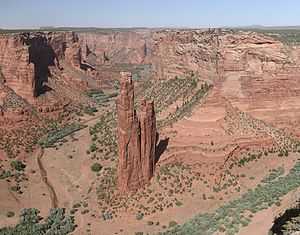Spider Grandmother

Legendary home to Spider Grandmother
Spider Grandmother (Sussistanako or Tse-che-nako)[1] is an important creation figure in the mythology, oral traditions and folklore of many Native American cultures.
Mythos
She is creator of the world in Southwestern Native American religions and myths such as that of the Pueblo and Hopi peoples. Although accounts vary, according to mythology she was responsible for the stars in the sky; she took a web she had spun, laced it with dew, threw it into the sky and the dew became the stars. Navajo mythology tells of Spider Woman or Spider Old-Woman (Na'ashjéii Asdzáá).[2]
According to the Zuni, string games were given to them by Grandmother Spider.[3] And was fire-bringer for Choctaw peoples.
Accounts
Oral
Traditionally, the stories involving Spider Grandmother are narratives passed down orally from generation to generation.
Traditional Navajo/Diné limit the telling of stories involving Spider Grandmother to the winter months, known as "the season when Thunder sleeps", when it is safe to discuss certain dangerous spirits, such as Spider Woman and Northern Thunder (whence the season takes its name), and esoteric topics, such as the Emergence narrative.
The Choctaw people of Tennessee and Mississippi tell the story of Grandmother Spider stealing fire, then after animals refused it, bringing fire to humans.[4]
G. M. Mullett has also written a book documenting the oral legends of the Spider Woman specific to the Hopi Indians. In these narratives, Spider Woman is also known as the Earth Goddess,[5] by the name of Kokyangwuti.[6][7]
In the Northwest, the Coos people of Oregon have their version of a Spider Grandmother traditional tale (Spider-Old-Woman).[8]
Other
Playwright Murray Mednick wrote seven one-act plays called The Coyote Cycle [9] with the same four characters: Coyote, Coyote trickster, Spider Grandmother and Mute Girl. These same characters come from traditional native American stories and myths.
Susan Hazen-Hammond, author of Penguin's Timelines of Native American History,[10] and at least eight other movies, has gathered numerous tales collected from various tribes and written these narratives in her book, Spider Woman's Web.[11] In this book, Spider Grandmother is also referred to by the names Spider Woman and Spider Old Woman.
See also
- Great Goddess of Teotihuacan, deity also known as "Teotihuacan Spider Woman"
- Spider Man, Spider Woman and Weaving section of the Diné Bahaneʼ article (Navajo: "Story of the people")
- Folklore and mythology section of the Cultural depictions of spiders article
References
- ↑ Snodgrass, Mary Ellen (2013), "Spider Woman and feminist literature", Encyclopedia of Feminist Literature, Infobase Learning, ISBN 1438140649.
- ↑ "Legendary Native American Figures: Spider Woman (Na'ashjéii Asdzáá)". Native Languages of the Americas. Retrieved 4 January 2014.
- ↑ Allan and Paulette Macfarlan (1958). Handbook of American Indian Games, p.189. ISBN 978-0-486-24837-0.
- ↑ "Grandmother Spider Steals the Fire" story
- ↑ Spider Woman Stories, published by The University of Arizona Press, 1979. ISBN 0-8165-0621-3
- ↑ "Kokyangwuti". MythologyDictionary. Retrieved 23 November 2012.
A creator-goddess of the Hopi. Daughter of Sotuknang
- ↑ "Spider Woman / from the Hopi people". Resources for Indigenous Peoples' Religious Traditions. John Carroll University. Retrieved 23 November 2012.
This story is taken from Leeming, The World of Myth, 36-39; Leeming cites G. M. Mullett, Spider Woman Stories: Legends of the Hopi (Tucson, AZ: 1979), 1-6.
- ↑ Frachtenberg, Leo J. (1913). Coos texts. California University contributions to anthropology (Vol. 1). New York: Columbia University Press. P.61
- ↑ The Coyote Cycles, Padua Playwright's Press, 1993. ISBN 978-0-9630126-1-6
- ↑ Timelines of Native American History Penguin Group (USA) 1997 ISBN 978-0-399-52307-6
- ↑ Spider Woman's Web, published by Penguin Group (USA) 1999 ISBN 978-0-399-52546-9
External links
- Spider-Old-Woman: — Coos people story from Internet Sacred Text Archive, collected by Leo J. Frachtenberg (1913).
- Spider Woman and the Holy Ones — Din'eh story by Adam Teller and Grandma Thompson.
- Grandmother Spider Steals the Fire — creation myth of the Choctaw people of Tennessee and Mississippi